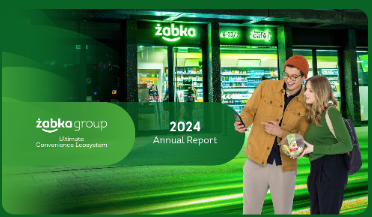Poznaj zakresy emisji
Zakres 1
Na drodze ku zrównoważonej przyszłości

Nasze emisje z zakresu 1 wynikają głównie ze spalania paliw w naszych instalacjach lub w procesach takich jak stosowanie czynników chłodniczych i eksploatacja naszej floty. Skupienie się na samochodach hybrydowych jest kluczowym elementem naszych wysiłków na rzecz dekarbonizacji floty, a obecnie testujemy pojazdy w 100% elektryczne. Naszym celem jest redukcja emisji z floty o ~0,6 tys. t CO2 w 2026 r. w stosunku do obecnych prognoz, zastępując 203 pojazdy w latach 2024-2026. Korzystając z pojazdów chłodniczych, ograniczamy również wykorzystanie suchego lodu w transporcie.
Zakres 2
Zasilani zieloną energią

Nasze emisje z zakresu 2 pochodzą z energii, którą kupujemy od dostawców, w tym energii elektrycznej zużywanej w naszej siedzibie głównej i centrach dystrybucyjnych, a także z ogrzewania sieciowego wykorzystywanego w centrali. Zgodnie z 15-letnią korporacyjną umową zakupu energii elektrycznej (cPPA) z Qair, zobowiązujemy się do zakupu energii elektrycznej i gwarancji pochodzenia z ich farmy wiatrowej i wielkoskalowej elektrowni słonecznej w latach 2023-2038. Stanowi to blisko 1,7 TWh energii odnawialnej. Podobny 10-letni kontrakt z firmą Modus mamy na dostawy rocznie blisko 50 GWh zielonej energii elektrycznej.
Zakres 3 (downstream)
Unowocześnianie sklepów franczyzowych

Pracujemy nad zmniejszeniem emisji franczyzobiorców i jesteśmy zaangażowani w badanie i wdrażanie nowych, skutecznych rozwiązań. To także nasza praca w laboratorium Żabka Eko Smart, gdzie badamy najnowsze innowacje z całego świata. W 2023 roku sukcesywnie optymalizowaliśmy nasze trasy dostaw pod kątem redukcji emisji CO₂. Wdrażamy systemy chłodnicze z zamkniętymi lodówkami i drzwiami zero-heating w sklepach, a także instalujemy panele fotowoltaiczne wszędzie tam, gdzie to możliwe. Wymieniamy również czynniki chłodnicze w instalacjach chłodniczych na tez niższym współczynnikiem GWP.
Zakres 3 (upstream)
Digitalizacja łańcucha wartości

Ściśle współpracujemy z naszymi partnerami biznesowymi, aby przeanalizować ślad węglowy naszego łańcucha dostaw w ramach różnych kategorii i stale przeglądamy bazę danych, aby obliczyć ich poziom zaangażowania w dekarbonizację. Stale rozwijamy analitykę dla kupowanych przez nas towarów i usług, a dwa lata temu stworzyliśmy nową kartę produktową dla producentów, która zawiera sekcję dotyczącą śladu węglowego. Wzbogaciliśmy naszą bazę danych w kategorii 1: Zakupione towary i usługi zgodnie z wymaganiami GHG Land Sector and Removals Guidance. Pogłębiamy naszą analizę, aby sprostać wyższym standardom wymaganym przez interesariuszy i przyszłym zmianom regulacyjnym. Nieustannie badamy również wpływ naszego zakresu 3 na różnorodność biologiczną i jesteśmy świadomi wzajemnego wpływu tych dwóch obszarów.
Przeczytaj więcej o dekarbonizacji
Analizy ryzyk Zautomatyzowanego Centrum Logistycznego w Radzyminie

Przeprowadziliśmy analizy ryzyk naszego Centrum Logistycznego w Radzyminie pod kątem transformacji biznesu i zmian społecznych wywołanych m.in. zmianami klimatu. Analiza została opracowana w 2025 r. zgodnie z wytycznymi TCFD (Task Force on Climate-related Financial Disclosures), Transition Risk Framework oraz Transition Risk Assessment Guidelines.
Ryzyka przejścia
Rozpoznanie ryzyk i szans, jakie powstają w kontekście zmian klimatu, pozwala na lepsze przygotowanie budynku i jego otoczenia na zmiany. Nowe wymagania techniczne i technologiczne, prawne i społeczne mogą przekładać się na większą potrzebę inwestycji w obszary pozwalające na przejście do gospodarki niskoemisyjnej. Z drugiej strony mogą również przyczyniać się do pozytywnych zmian, takich jak np. ograniczenie zużycia energii i wody, redukcja wytwarzanych odpadów lub bardziej pozytywne postrzeganie danej inwestycji przez społeczność lokalną. Dla budynku objętego analizą wyznaczyliśmy również odpowiednie współczynniki, które będą monitorowane. W zakresie ryzyk transformacji, ocenie podlegać będzie: ograniczenie zużycia energii i wody, ograniczenie wytwarzania odpadów oraz wykorzystanie terenów zielonych.
Analiza scenariuszowa przeprowadzona dla Żabka Polska sp. z o.o., w tym Zautomatyzowanego Centrum Logistycznego w Radzyminie, pozwala ocenić wpływ ryzyk związanych z transformacją klimatyczną. Skupiliśmy się na trzech scenariuszach: BAU (business as usual), SSP2-4.5 i SSP5-8.5. Scenariusze SSP (Shared Socio-economic Pathways) to prognozy rozwoju społeczno-gospodarczego, które pomagają zrozumieć możliwe kierunki zmian — m.in. w zakresie środowiska, gospodarki czy polityki energetycznej — w kontekście zmian klimatu.
W analizie wykorzystaliśmy uznane modele klimatyczne, m.in. z WBCSD, IMF oraz NGFS scenarios explorer. Uwzględniliśmy trzy horyzonty czasowe: krótki (1 rok), średni (do 2030 roku) i długi (do 2050 roku), przy czym największe zmiany spodziewane są w dłuższej perspektywie. Dla każdego ze scenariuszy oceniliśmy możliwy wpływ na wybrane wskaźniki finansowe w latach 2024–2050.
Wśród kluczowych ryzyk transformacyjnych zidentyfikowaliśmy m.in. zmiany rynkowe i technologiczne, prognozowany wzrost cen energii oraz zakłócenia w dostawach surowców. Zmiany popytu wynikają z trendów makroekonomicznych, które są kształtowane przez zmieniające się warunki klimatyczne. Wzrost cen energii to efekt zarówno obecnej sytuacji rynkowej, jak i konieczności długoterminowej transformacji energetycznej. Zakłócenia w dostępności surowców i materiałów również mogą mieć istotny wpływ na działalność operacyjną.
Analiza scenariuszy SSP2-4.5 i SSP5-8.5 pokazuje podobne zmiany w popycie oraz względnie stabilną strukturę kosztów. W scenariuszu SSP2-4.5 zakładamy silny wpływ regulacji ESG i większą przewidywalność kosztów energii. Z kolei scenariusz SSP5-8.5 przewiduje ograniczony wpływ regulacji ESG, zmienność kosztów własnych oraz opóźnioną transformację rynku energetycznego. W obu przypadkach skumulowane ryzyka obejmują m.in. zmiany popytu, wzrost cen energii i paliw, zmiany w dostawach surowców, niepewność sygnałów rynkowych, zmiany regulacyjne oraz możliwość ograniczeń w zakresie transportu towarów w centrach miast.
Ryzyka społeczne
W zakresie ryzyk społecznych, obiekt został oceniony pod kątem narażenia na szereg zagrożeń społecznych. Dla każdego rozpoznanego ryzyka zidentyfikowano przykładowe działania przekładające się na potencjalne zwiększanie pozytywnego wpływu na społeczności lokalne. Ocena oparta została na danych potwierdzających obecność oraz poziom wpływu różnych zagrożeń społecznych wokół obiektu. Wykorzystano w niej badania wykonane przez instytucje publiczne i prywatne, które dobierano adekwatnie do zakresu występowania każdego problemu: lokalnego, dzielnicowego, miejskiego i ogólnopolskiego. W analizie uwzględniliśmy wytyczne systemu certyfikacji BREEAM International In-Use (wersja 6). Pokrywają one następujące obszary:
· Ubóstwo: nierówności dochodowe; sytuacja bezrobocia,
· Zakłócenia społeczne: bezpieczeństwo, starzejące się społeczeństwo, imigracja, wsparcie rodziny/społeczności, dostępność, nierówność, różnorodność religijna,
· Współczesne niewolnictwo: praca przymusowa,
· Zdrowie publiczne: jakość powietrza, zanieczyszczenie światłem, zanieczyszczenie hałasem,
· Ryzyka fizyczne związane z klimatem: ekstremalne warunki pogodowe.
Każda z analizowanych kategorii obejmuje konkretne zjawiska oceniane pod kątem ich potencjalnego wpływu i związanego z nimi ryzyka. We wszystkich przypadkach poziom ryzyka został określony jako niski lub umiarkowany. Ocena ta daje pełny obraz wyzwań społecznych, przed którymi może stanąć dany obiekt, i podkreśla, jak ważne jest ich odpowiednie adresowanie, by wspierać zdrową i zrównoważoną społeczność.
W analizie wskazano również możliwe działania i strategie łagodzące, które mogą zwiększyć odporność społeczną. Skupienie się na tych rozwiązaniach pozwala interesariuszom skutecznie reagować na zidentyfikowane wyzwania i tworzyć bardziej inkluzyjne, wspierające środowisko dla mieszkańców, najemców, użytkowników i odwiedzających. Takie podejście do kwestii społecznych jest kluczowe dla promowania odpowiedzialności w biznesie i zapewnienia, że pozostajemy wrażliwi na potrzeby społeczności.
Dowiedz się więcej o SBTi

Żabka Polska jest pierwszą firmą w Polsce, której cele dotyczące redukcji gazów cieplarnianych zostały zwalidowane przez Science Based Targets Initiative. SBTi jest wspólną, międzynarodowa inicjatywa CDP (dawniej Carbon Disclosure Project), Global Compact Organizacji Narodów Zjednoczonych, World Resources Institute (WRI) oraz WWF (World Wildlife Fund).
Jaka jest rola SBTi?
SBTi pomaga firmom określić, jak dużo i jak szybko muszą zmniejszyć swoje emisje gazów cieplarnianych, aby być zgodnym z wymaganiami najnowszych badań klimatycznych. Celem nadrzędnym organizacji jest ograniczenie globalnego ocieplenia do 1,5 stopnia Celsjusza powyżej poziomów przedindustrialnych, zgodnie z Porozumieniem Paryskim z 2015 roku.
Dlaczego warto przystąpić do SBTi?
Zatwierdzenie strategii dekarbonizacynej przez SBTi jest bardzo szanowanym zobowiązaniem w biznesie i zabiegają o nie wszystkie firmy chcące być liderem zrównoważonego rozwoju w swojej branży. Jako firma chcąca minimalizować swój negatywny wpływ na środowisko, nieustannie poszukujemy rozwiązań, które nam na to pozwolą i zarazem będą przeciwdziałać zmianom klimatu – pracujemy nad zmniejszeniem zużycia energii, poszukujemy nisko- i zeroemisyjnych źródeł energii, testujemy innowacyjne zielone technologie oraz zachęcamy naszych konsumentów do dokonywania przyjaznych Planecie wyborów.
Jak wygląda proces aplikacji do SBTi?
- Zobowiązanie – złożenie listu deklarującego zamiar wyznaczenia celu opartego o wiedzę naukową w ciągu 2 lat od wysłania zobowiązania;
- Utworzenie strategii dekarbonizacji – zgodnie z kryteriami SBTi;
- Weryfikacja – złożenie aplikacji i walidacja celu przez SBTi;
- Komunikacja – publiczne ogłoszenie celów i poinformowanie interesariuszy;
- Ujawnianie – coroczna publikacja emisji organizacji oraz progres do osiągnięcia celów.
Jakie są dalsze kroki po walidacji celów?
Oprócz pracy nad realizacją strategii i spełnieniu celów, należy monitorować wymagania SBTi, ponieważ ulegają regularnej aktualizacji i rozszerzeniu. Przykłady istotnych zmian w kryteriach:
- Zmiana minimalnej ambicji celów z “well below 2°C” do 1,5°C co w rezultacie oznacza między innymi zwiększenie minimalnej rocznej redukcji emisji z zakresu 1 i 2 do 4,2% rocznie;
- Włączenie emisji z grupy FLAG (Forest, Land and Agriculture) do zakresu raportowania.
Istotne zmiany w sposobie raportowania emisji organizacji również należy skonfrontować z wytycznymi SBTi, gdyż mogą one wpłynąć na status akceptacji celów:
- Zmiana alokacji grupy emisyjnej do innego zakresu;
- Zmiany kontroli operacyjnej wewnątrz organizacji.
Realizacja strategii dekarbonizacji w 2023 roku
Strategia Odpowiedzialności Grupy Żabka nakreśla nasze aspiracje i ścieżki rozwoju w sektorze ESG. Wypełnianie przyjętych zobowiązań wymaga wsparcia wszystkich naszych pracowników i partnerów. Wspólne poświęcenie pozwoliło nam skutecznie stawić czoła wyzwaniom minionego roku, a także wykorzystać liczne możliwości. Naszymi codziennymi działaniami zbliżamy się do realizacji ambicji zawartych w Strategii Odpowiedzialności Grupy Żabka. Wyniki, w stosunku do celów na 2023 r. prezentują się następująco:
Cel zakresu 1 i 2
Łączna emisja gazów cieplarnianych z zakresu 1 i 2 wyniosła 17 282 ton CO2e, co daje najwyższy dostępny wynik KPI. Dzięki dalszym inwestycjom w naszą flotę, w tym wymianę pojazdów oraz wdrożeniu programu motywacyjnego dla kierowców, utrzymaliśmy emisje w tym obszarze na poziomie z ubiegłego roku. Stało się tak pomimo wzrostu liczby samochodów. Nasze wysiłki w ciągu ostatnich dwóch lat mające na celu zminimalizowanie wycieków w systemach chłodniczych w naszych centrach dystrybucyjnych oraz zastąpienie czynników chłodniczych o wysokim potencjale tworzenia efektu cieplarnianego (GWP) czynnikami o niższym współczynniku GWP również przyczyniły się do zmniejszenia emisji. Ponadto kontynuowaliśmy nasze podejście polegające na dostarczaniu w 100% odnawialnej energii elektrycznej w operacjach własnych, wykorzystując gwarancje pochodzenia energii odnawialnej (REGO), aby wykazać, że została ona wytworzona ze źródeł odnawialnych. Korzystając z floty pojazdów chłodniczych, ograniczyliśmy również wykorzystanie suchego lodu w transporcie. W związku z tym, nasze emisje z zakresu 1 i 2 zmniejszyły się o 28,8% w porównaniu z poziomem bazowym z 2020 roku.
Cel zakresu 3 (downstream)
W zakresie 3 nadal koncentrujemy się na inicjatywach związanych z efektywnością energetyczną. Zastosowaliśmy zamknięte systemy chłodnicze do napojów w prawie 1,200 nowych sklepach i zero heating doors w blisko 2,000 sklepach. Oba rozwiązania są standardem w nowo otwieranych sklepach. Dodatkowo zadbaliśmy o to, aby 46% energii elektrycznej zużywanej w sklepach pochodziło ze źródeł odnawialnych, nie tylko poprzez zakup gwarancji pochodzenia, ale także poprzez zainstalowanie kolejnych 100 instalacji PV na dachach naszych sklepów. W efekcie intensywność emisji z zakresu 3 ze sklepów naszych franczyzobiorców spadła o 60% w stosunku do roku bazowego 2020.
Cel zakresu 3 (upstream)
Jeśli chodzi o emisje z zakresu 3 upstream, firma ściśle współpracuje ze swoimi partnerami biznesowymi w celu analizy śladu węglowego ich łańcucha dostaw w ramach różnych kategorii i stale przegląda bazę danych, aby obliczyć ich poziom zaangażowania w dekarbonizację. Strategia firmy zakłada, że do 2026 r. 75% jej dostawców pod względem wydatków, obejmujących zakupione towary i usługi, będzie miało cele oparte na podstawach naukowych.
Co jeszcze możemy wspólnie ulepszyć




